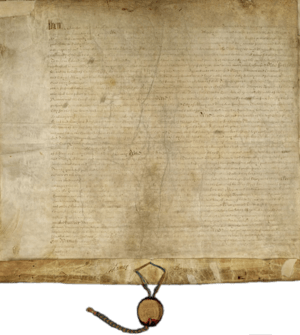Dongan Charter facts for kids
Quick facts for kids Dongan Charter |
|
 Opening paragraph of the Dongan Charter
|
|
| Ratified | July 25, 1686 |
| Location | Albany County Hall of Records |
| Authors | Governor Thomas Dongan |
| Purpose | Incorporated the City of Albany |
The Dongan Charter is a very old and important paper from 1686. It officially made Albany, New York a city. This document was given by Governor Thomas Dongan. He was the governor of the Province of New York at the time.
Governor Dongan also gave a similar, but shorter, charter to New York City a few months earlier. Albany became a city three years after Albany County was formed. The Dongan Charter is the oldest city charter in the United States that is still used today. A historian named Stefan Bielinski said it's probably the longest-running city government document in the Western Hemisphere. In 1936, the United States Congress even made a special coin to celebrate the charter's 250th birthday.
Contents
How Albany Got Its City Charter
After New York City got its charter, Governor Dongan visited Albany. The people of Albany, who lived in a village then, asked him for their own charter. The Patroon, who was a large landowner, finally agreed to give up his claims to Albany. He also gave a strip of land, about 1 mile (1.6 km) wide and 16 miles (26 km) long, to Albany.
At that time, Albany had about 500 people living in 140 houses. In July 1686, a group led by Pieter Schuyler and Robert Livingston went to New York City. They went to get the charter for Albany. The charter was signed on July 25, 1686. It was read aloud to the people of Albany three days later. Because England and Albany used the Julian calendar back then, the actual date on our modern Gregorian calendar would be August 1, 1686.
Challenges to the Charter
The Dongan Charter faced challenges over time. During Leisler's Rebellion, a leader named Jacob Leisler wanted Albany and New York City to give up their charters. New York City agreed, but Albany's mayor, Pieter Schuyler, said no. Schuyler became a key leader in stopping the rebellion.
Later, during the American Revolution, the city's government, called the Common Council, stopped meeting in 1775. A local group, the Committee of Safety, took over running the city. The Common Council started meeting again in 1778.
Celebrating the Charter's History
In 1936, a "Dongan Charter Parade" was held to celebrate the 250th anniversary. The United States Congress allowed a special half dollar coin to be made for the event.
In 1986, for the 300th anniversary, there was a re-enactment of the charter signing. Governor Mario Cuomo played Governor Dongan, and Mayor Thomas Whalen played Mayor Schuyler. Other celebrations included fireworks, music, a new clock, a hot-air balloon launch from Lincoln Park, and a huge cake for thousands of people. Mayors from other cities named Albany around the world were invited and given a tour.
What the Charter Did for Albany
The Dongan Charter changed the village of Albany into a city. Its official name became "The Mayor, Aldermen, and Commonalty of the city of Albany." This document also legally separated Albany from Rensselaerswyck, a large colonial estate nearby.
The charter set up Albany's city limits and its government. It even named the first city officials. It also gave Albany special rights. For example, Albany had the only right to talk and trade with the Native Americans in the area. It also made Albany the only main market town in the upper Hudson River region. This meant most trading had to happen there.
City Government Structure
The mayor of Albany was the main leader. The Lieutenant Governor chose him. The mayor was also in charge of the marketplace and acted as the coroner for both the city and Albany County.
Two aldermen and two assistant aldermen were chosen from each part of the city, called a ward. They, along with the mayor and a recorder (a legal officer), formed the Common Council. The mayor, recorder, and aldermen also acted as judges. However, the assistant aldermen did not have judicial powers.
The mayor and Common Council had the only right to allow trading in all of Albany County. At that time, Albany County covered a huge area. It included all of Upstate New York north and west of Ulster County, and even the state of Vermont. People from other parts of New York were not allowed to trade with the Iroquois nations or other native tribes in or around Albany County.
Changes to the Charter Over Time
The Dongan Charter was first changed on March 21, 1787. This change removed the mayor's power to be the only coroner and to control trade with Native Americans. The charter continued to be used with only small changes until 1870.
In 1870 and 1883, the state legislature made big changes to the charter. In 1870, the city's official name was shortened from "The Mayor, Aldermen, and Commonalty of the city of Albany" to simply the "City of Albany." In 1998, the charter was almost completely rewritten after a public vote. But legally, this new version was still considered an amendment, or change, to the original Dongan Charter.
Commemorative Coin
On June 16, 1936, the United States Congress allowed 25,000 special half dollar coins to be made. These coins celebrated the 250th anniversary of the Dongan Charter.


